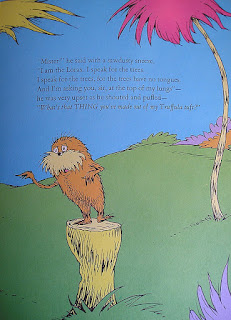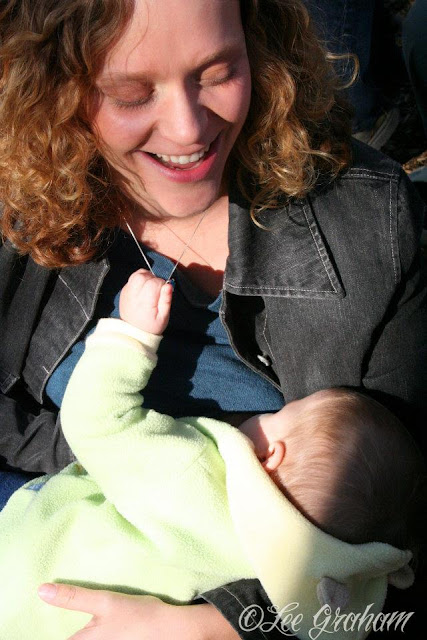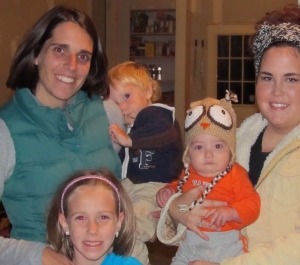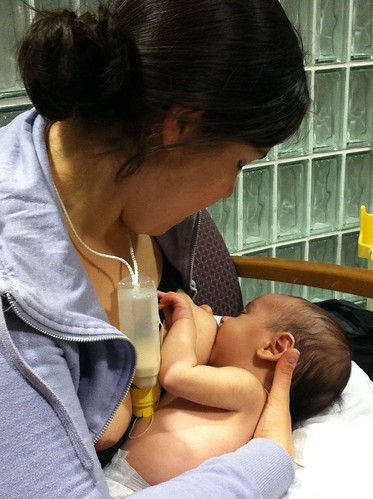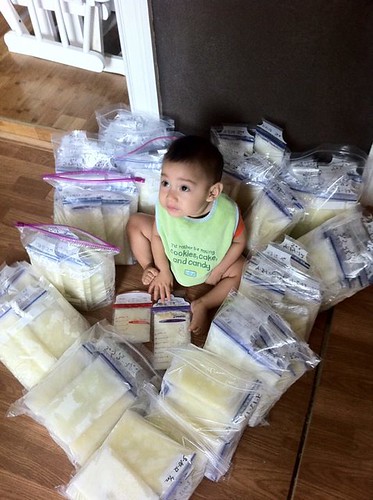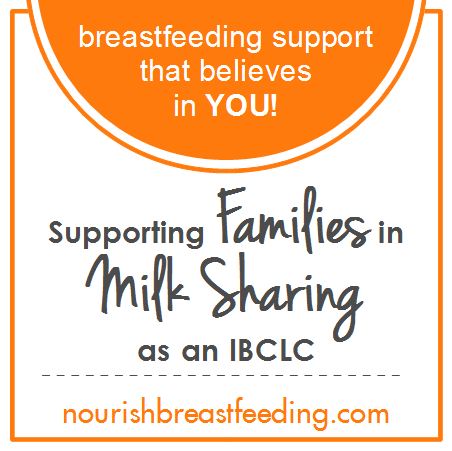Milk-Sharing: Safe Infant Feeding and Being a Human
from Sustainable Mothering
Back in the 1990s, I had more breast milk than I could handle. I knew then and know now that many women, due largely to the circumstances of their lives and not their biology, are not able to produce all the milk their children need. And there are breastfeeding people (some cis-female and some not) who have biological reasons why they can't produce enough breast milk for their children.
Well, that is where people like me can come in.
By the second trimester of my first pregnancy, my perfectly happy "Barely B" cups had become G cups. I didn't know there were G cups and never had desired to own them. When my first son was born, I pumped in the fruitless hope that he would drink breast milk from a bottle while I was in court. He had other ideas. Then I pumped for comfort because I was constantly engorged. I could pump eight ounces in five minutes, switch bottles, and pump another eight ounces. But my son would have none of it. He wanted breasts or nothing.
Pretty soon I had a freezer stocked full of pumped breast milk my son wouldn't drink. So, after some research, I contacted HMBANA in the hope of finding a good home for my gallons of milk. But I was also on an SSRI at the time – one then and now considered entirely safe for breastfeeding children. The HMBANA policy, I was told then, was that no milk donations would be accepted if the donor was on any medications whatsoever. So HMBANA would not accept my milk.
When son number two was born, not only did I have over supply but overactive let-down. That meant my first let-down would hit the back of my son's throat with such force it triggered his gag reflex and he chomped down in an attempt to slow the flow. There are only so many times a baby, affectionately nicknamed "Moose" for his ten pound birth weight and trap-like mandibles, can chomp on your nipples before something must be done. That something was pumping before each feed so that my let-down was not so fast. And that meant more gallons of breast milk in my freezer.
There were no informal milk-sharing networks on the Internet in the nineties. Or if there were, I didn't know about them. So I was forced to pour gallon after gallon of breast milk down the drain.
Menschheit is a difficult word to translate. Literally it is the German noun meaning "humanity" or "mankind," but I grew up hearing it used in Yiddish to describe a quality – the quality of acting like a real human being. This, in Yiddish, is considered a good thing. Giving my abundant excess breast milk to a baby who needed it seemed to me to be the most basic menschheit. It is what a person does if she is really human.
It made me incredibly sad that I couldn't find a home for my breast milk. And it makes me very happy that today people with excess milk can find other people who need milk and make the exchange. This is menschheit; it was what humans do for one another.
Following is a post written by economist and breastfeeding expert James Akre about the safety and necessity of milk-sharing. It was originally published by baby gooroo on June 28th and is reprinted here with the kind permission of Akre and baby gooroo:

-
Since pre-history, mothers in need of human milk have relied on other
mothers in their family and community with milk to spare and share.
According to the World Health Organization (WHO) and UNICEF, the
second-best feeding option, after breastfeeding, is breast milk
expressed by a child’s own mother, followed by milk from a healthy
wet-nurse or from a human-milk bank.
- The Human Milk Banking Association of North America (HMBANA)
acknowledges that its not-for-profit member banks—two in Canada and 11
in the U.S. serving a total population approaching 350 million — cannot
satisfy even a quarter of the current demand for banked milk. Under the
circumstances HMBANA rightly gives priority to sick and premature
babies. But at $3–$6 an ounce, a week’s supply could cost as much as
$750—something few parents can afford to pay even if banked milk were
available.
“A growing awareness of the importance of breast milk for babies has accelerated the demand for human milk at a time when processed donor milk is scarce and costly,” says Amy Spangler, president of baby gooroo. “Intent on giving their babies what every baby needs most, mothers are bypassing milk banks and going directly to the supplier—other breastfeeding mothers with milk to spare.”
The Milk-Sharing Debate
With the help of social media, mothers are increasingly aware that milk-sharing is a viable option for mothers who can’t breastfeed or obtain banked milk. Mothers of healthy babies who need milk are linking with other mothers willing to donate milk via chapters of two popular Facebook-based communities—Eats on Feets and Human Milk 4 Human Babies—operating in more than 50 countries.
These online communities allow donor mothers to share their milk, safely and ethically, in the belief that they and recipient mothers are capable of weighing the inherent benefits and risks and making informed decisions. This altruistic commerce-free exchange is grounded in the principle that all who are involved in milk sharing take full responsibility for their actions and subsequent outcomes.
However, the position staked out by some public health authorities, notably in Canada, France, Israel, and the U.S., including the Canadian Paediatric Society and the American Academy of Pediatrics is clear: Don’t do it!
Some in the health and medical establishment regard internet-based sharing as a threat both to their authority and to public health. They reject a system that operates outside their influence, that can’t be regulated, and where mothers alone exercise control. Some especially anxious observers go so far as to allege that mother-to-mother milk sharing undermines the ability of the few under-provisioned human-milk banks to meet the urgent needs of sick and preterm babies, by further reducing potential milk donations.
It should be noted that donor mothers have been breastfeeding their own children. With few exceptions, these mothers and their children are being followed closely by health care professionals with all that this implies for health status monitoring; and they are ready to discuss their lifestyle and disclose their medical records before sharing their milk. And yet health authorities are contending that mother-to-mother milk sharing is fundamentally riskier than feeding infant formula, and that it’s impossible for mothers, acting on their own, to minimize health risks.
Those in favor of milk sharing disagree.
Weighing and Managing Relative Risk
Milk banks function according to a strict medical model where regulations, rules, and protocol determine what is done, when, and for whom. Babies receiving banked donor milk are virtually always sick and hospitalized; healthy children seldom qualify for access to the limited amount of banked milk. Health professionals prescribe milk for the sickest, neediest, and most fragile babies, who are frequently immuno-compromised and risk death.
In addition, the screening criteria that milk banks typically apply disqualify many otherwise healthy women who might be willing to donate their milk. Exclusion criteria include previous residence in the UK (due to possible infection with mad cow disease), regular consumption of caffeinated beverages, a baby older than 6 months of age, and a small amount of available milk.
In contrast, milk sharing takes place in the community where interpersonal contact plays a significant role. Typically, the personalities and values of those involved are largely responsible for influencing decisions; the children concerned are healthy; and mothers are motivated by a heightened awareness of the importance of human milk for human babies and a desire to contribute to the common good.
There are risks associated with milk sharing just as there are with feeding babies formula.
It is thus a question of weighing and managing relative risk, minimizing potential harm, and maximizing benefit. Rather than resisting and dismissing milk sharing, the constructive approach would be for health authorities and health care professionals to engage with mothers in ways that help make the practice as safe as possible, such as providing reliable information on donor screening, milk collection, storage, pasteurization, and feeding practices, and expediting voluntary sharing of medical records.
There are encouraging signs of a more nuanced attitude among health professionals. For example, based on their survey of more than 400 health professionals, two researchers from the University of Wisconsin School of Medicine and Public Health in 2010 concluded that those knowledgeable about breastfeeding overwhelmingly support wet-nursing and sharing of unpasteurized human milk. The majority of those surveyed recommended that donors should be screened like blood donors, and should be instructed on safe milk handling and storage techniques. Although health professionals view all infants as possible candidates for unpasteurized donor human milk, concerns remain about safety and social problems with wet-nursing and milk sharing. Lastly, survey participants agreed that professional recommendations should be developed to optimize safety and acceptance of wet-nursing and human-milk sharing.
What the Milk-sharing Community Advises
The four pillars to support the safe sharing of breast milk from Eats on Feets stress:
- Informed Choice — Mothers are responsible for understanding
the options, including the risks and benefits, of all infant and child
feeding methods.
- Donor Screening — Mothers can communicate with donors by
asking questions about their health and lifestyle, and by requesting
blood screening test results.
- Safe Handling — Mothers and donors should handle milk with clean hands and equipment and use proper storage methods.
- Home pasteurization — If in doubt, mothers can pasteurize
milk at home: on the stovetop in order to inactivate HIV; or using a
single bottle pasteurizer that performs the Holder method of
pasteurization.
Full Disclosure Reduces Risk
Suggested points of discussion can include medications, alcohol and drug use. In many countries, testing for infectious diseases is done during routine prenatal/antenatal care. You may be able to consult a health care provider to obtain further testing if desired. You can ask for copies of those test results. If you cannot get a complete picture of the health of your donor, one option is to look into at-home pasteurization.
Mother-to-mother human-milk sharing is here to stay. Though technology has transformed the practice, it remains fundamentally identical to what mothers of good will have been doing since pre-history on behalf of other mothers and their babies.
Not-for-profit human-milk banks and commerce-free mother-to-mother milk sharing can and should operate on parallel non-competitive tracks. They are complementary, not antagonistic. Indeed, there is significant untapped potential for both systems to play mutually supportive roles in pursuit of a single common objective—helping to ensure that no babies are denied their nutritional birthright.

